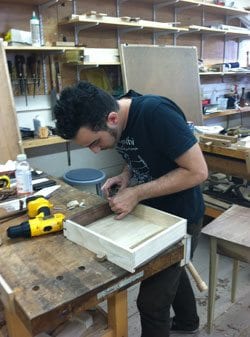
“We are working away from being Boston’s best kept secret,” says Rob O’Dwyer, director of admissions at the North Bennet Street School.
The school, nestled between the bistros and bakeries of the North End, attracts students from all over the world. But this isn’t the traditional university setting in Boston. The smell of fresh sawdust is in the air and students are hunched over projects and machines instead of books.
The North Bennet Street School has been transformed since opening in 1881, but the school still retains its original focus on craftsmanship, fueled by the passion and drive of their students.
“It’s the technical side of passion,” says O’Dwyer. Major motivators for students, he says, are their sincere interest in the craft, what the training has to offer and their personal goals.
The school, which began as a settlement house for immigrants at its inception, now offers programs in various trades and craftsmanship. Areas of study — mostly two-year programs, range from restoration carpentry to bookbinding to violin making.
Keith Ward, 63, is a first-year student in the piano technology program.
“In a nutshell, this has been one of the only things in my life that I’ve had no regrets about the time, money or effort,” Ward says.
Primarily a musician, Ward had a career in computers until the economic downturn and outsourcing left him without a job. The change gave him the opportunity to pursue a new goal that matched his passion.
“It saves my bacon,” Ward says. “There’s an overwhelming sense of cooperation.”
Brad Wolcott, a fourth-semester student, says there are not many students who don’t want to come in to school every day. In fact, many inquire whether they can also come in on the weekends.
Even though the first few years after graduation can sometimes be hard, says Wolcott, “You love what you do, that’s the thing that keeps people going.”
The student body of 157 includes a variety of ages and backgrounds. Wolcott says many of his fellow students came here to pursue a new career from being software engineers, programmers, or lawyers. One furniture and cabinetry student said he’d served as public defender for 31 years.
Andrew Hayes, 35, a student of the preservation carpentry program, finally made the decision to join his program when presented with a promotion at his former job.
“I thought, ‘this was not what I want to do for the rest of my life,’ ” said Hayes. “I decided to roll the dice and take a chance on enjoying what I do for the next 30 to 40 years.”
Despite the school’s history and focus on traditional trades, the faculty and students are embracing the possibilities of modern technology. O’Dwyer says students often use a blog to track their progress and drive interest to their work, sell their goods on Etsy and Custom Made, and receive emails about open jobs from studios all over the world.
“To think of crafts as incompatible to technology is to do it a disservice.” O’Dwyer says. “I have a feeling we’re going to reach a tipping point of visibility that this school hasn’t seen before, and it has everything to do with the Internet.”
While the school has some programs — like locksmithing and jewelry making — in which they are working to increase application numbers, interest is growing overall. For many programs, they receive far more applications than spots available, and several programs have a wait list.
“It’s energizing to be able to put detailed work and energy into an object that’s going to have a practical use,” O’Dwyer says. “If there’s anything this school is about, it’s about enriching people’s lives.”






